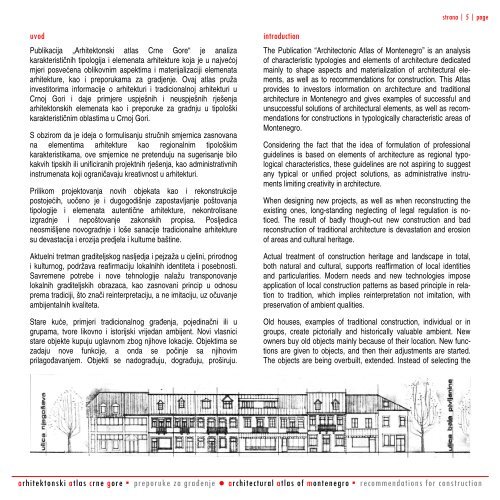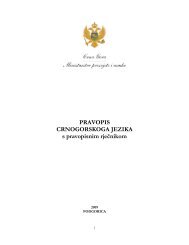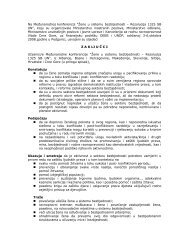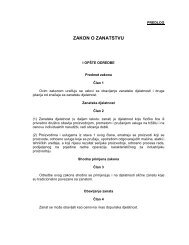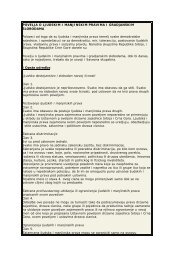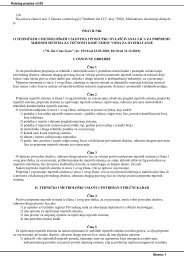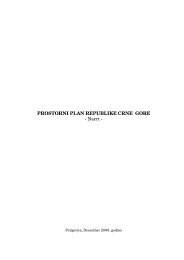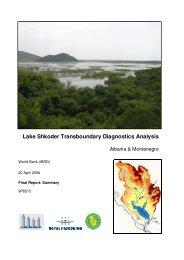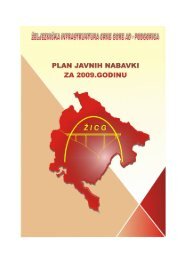arhitektonski atlas crne gore architectural atlas of ... - Vlada Crne Gore
arhitektonski atlas crne gore architectural atlas of ... - Vlada Crne Gore
arhitektonski atlas crne gore architectural atlas of ... - Vlada Crne Gore
Create successful ePaper yourself
Turn your PDF publications into a flip-book with our unique Google optimized e-Paper software.
strana | 5 | pageuvodPublikacija „Arhitektonski <strong>atlas</strong> <strong>Crne</strong> <strong>Gore</strong>“ je analizakarakterističnih tipologija i elemenata arhitekture koja je u najvećojmjeri posvećena oblikovnim aspektima i materijalizaciji elemenataarhitekture, kao i preporukama za gradjenje. Ovaj <strong>atlas</strong> pružainvestitorima informacije o arhitekturi i tradicionalnoj arhitekturi uCrnoj Gori i daje primjere uspješnih i neuspješnih rješenja<strong>arhitektonski</strong>h elemenata kao i preporuke za gradnju u tipološkikarakterističnim oblastima u Crnoj Gori.S obzirom da je ideja o formulisanju stručnih smjernica zasnovanana elementima arhitekture kao regionalnim tipološkimkarakteristikama, ove smjernice ne pretenduju na sugerisanje bilokakvih tipskih ili unificiranih projektnih rješenja, kao administrativnihinstrumenata koji ograničavaju kreativnost u arhitekturi.Prilikom projektovanja novih objekata kao i rekonstrukcijepostojećih, uočeno je i dugogodišnje zapostavljanje poštovanjatipologije i elemenata autentične arhitekture, nekontrolisaneizgradnje i nepoštovanje zakonskih propisa. Posljedicaneosmišljene novogradnje i loše sanacije tradicionalne arhitekturesu devastacija i erozija predjela i kulturne baštine.Aktuelni tretman graditeljskog nasljedja i pejzaža u cjelini, prirodnogi kulturnog, podržava reafirmaciju lokalnihh identiteta i posebnosti.Savremene potrebe i nove tehnologije nalažu transponovanjelokalnih graditeljskih obrazaca, kao zasnovani princip u odnosuprema tradiciji, što znači reinterpretaciju, a ne imitaciju, uz očuvanjeambijentalnih kvaliteta.Stare kuće, primjeri tradicionalnog građenja, pojedinačni ili ugrupama, tvore likovno i istorijski vrijedan ambijent. Novi vlasnicistare objekte kupuju uglavnom zbog njihove lokacije. Objektima sezadaju nove funkcije, a onda se počinje sa njihovimprilagođavanjem. Objekti se nadograđuju, dograđuju, proširuju.introductionThe Publication “Architectonic Atlas <strong>of</strong> Montenegro” is an analysis<strong>of</strong> characteristic typologies and elements <strong>of</strong> architecture dedicatedmainly to shape aspects and materialization <strong>of</strong> <strong>architectural</strong> elements,as well as to recommendations for construction. This Atlasprovides to investors information on architecture and traditionalarchitecture in Montenegro and gives examples <strong>of</strong> successful andunsuccessful solutions <strong>of</strong> <strong>architectural</strong> elements, as well as recommendationsfor constructions in typologically characteristic areas <strong>of</strong>Montenegro.Considering the fact that the idea <strong>of</strong> formulation <strong>of</strong> pr<strong>of</strong>essionalguidelines is based on elements <strong>of</strong> architecture as regional typologicalcharacteristics, these guidelines are not aspiring to suggestany typical or unified project solutions, as administrative instrumentslimiting creativity in architecture.When designing new projects, as well as when reconstructing theexisting ones, long-standing neglecting <strong>of</strong> legal regulation is noticed.The result <strong>of</strong> badly though-out new construction and badreconstruction <strong>of</strong> traditional architecture is devastation and erosion<strong>of</strong> areas and cultural heritage.Actual treatment <strong>of</strong> construction heritage and landscape in total,both natural and cultural, supports reaffirmation <strong>of</strong> local identitiesand particularities. Modern needs and new technologies imposeapplication <strong>of</strong> local construction patterns as based principle in relationto tradition, which implies reinterpretation not imitation, withpreservation <strong>of</strong> ambient qualities.Old houses, examples <strong>of</strong> traditional construction, individual or ingroups, create pictorially and historically valuable ambient. Newowners buy old objects mainly because <strong>of</strong> their location. New functionsare given to objects, and then their adjustments are started.The objects are being overbuilt, extended. Instead <strong>of</strong> selecting the<strong>arhitektonski</strong> <strong>atlas</strong> <strong>crne</strong> <strong>gore</strong> ▪ preporuke za građenje ● <strong>architectural</strong> <strong>atlas</strong> <strong>of</strong> montenegro ▪ recommendations for construction


